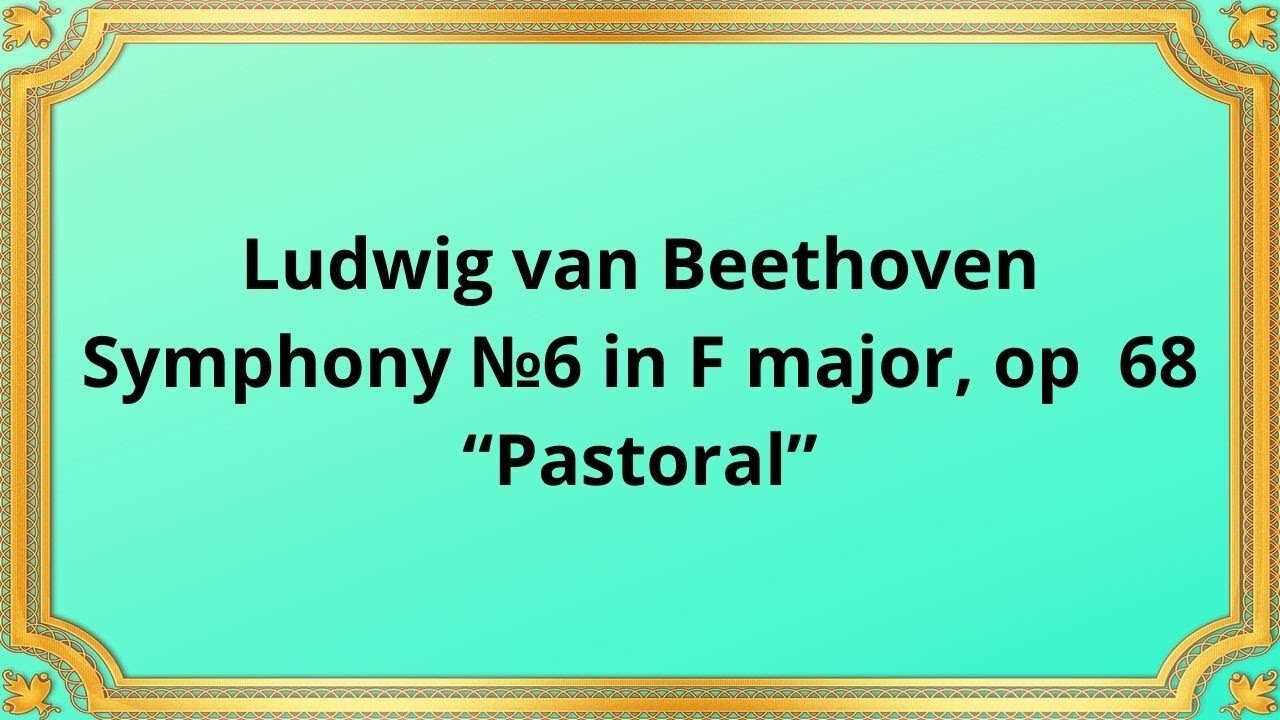Premium Only Content

Ludwig van Beethoven Symphony №6 in F major, op 68 “Pastoral”
#Beethoven #SymphonyNo6 #ClassicalMusic #PastoralSymphony #Opus68 #NatureInspiredMusic
#RomanticEra #MusicalStructure #BeethovenSymphony
Ludwig van Beethoven Symphony №6 in F major, op. 68 “Pastoral”
Prometheus, op. 43, Opening
Dutch Philharmonic Orchestra – Walter Goehr, cond.
Ludwig van Beethoven's Symphony No. 6 in F major, Op. 68, known as the "Pastoral Symphony," stands as a testament to the composer's ability to evoke the beauty of nature through music.
Ludwig van Beethoven, a revolutionary figure in the realm of classical music, composed the Symphony No. 6 in F major, "Pastoral," during the early 19th century. Beethoven's works were pivotal in bridging the gap between the Classical and Romantic eras, and this symphony is a prime example of his musical evolution. The "Pastoral Symphony" was composed during a time when Beethoven sought solace in nature, finding inspiration and respite from the challenges he faced in his personal life.
The Symphony No. 6 in F major consists of five movements, each depicting different aspects of nature. The first movement, "Awakening of cheerful feelings upon arrival in the countryside," sets the tone with its lively and joyful melodies. The second movement, "Scene by the brook," portrays the tranquility and gentle flow of a babbling brook. The third movement, "Merry gathering of country folk," is a lively and spirited dance, evoking the sense of community and celebration. The fourth movement, "Thunderstorm," creates a dramatic and tumultuous atmosphere, capturing the raw power of nature. Finally, the fifth movement, "Shepherd's song. Happy and thankful feelings after the storm," brings a sense of peace and contentment, concluding the symphony with a serene and reflective melody.
Beethoven masterfully employs various musical techniques to convey the essence of nature throughout the "Pastoral Symphony." He utilizes orchestral colors, dynamic contrasts, and recurring motifs to paint a vivid sonic picture. The symphony incorporates delicate woodwind solos, shimmering strings, and powerful brass passages to evoke the sounds and moods of the natural world. Beethoven's use of descriptive titles for each movement further enhances the connection between the music and the listener's imagination, allowing them to envision the scenes and emotions being portrayed.
The "Pastoral Symphony" takes listeners on an emotional journey, inviting them to immerse themselves in the beauty and tranquility of nature. It captures the awe-inspiring power of the natural world, the serenity of the countryside, and the resiliency of the human spirit. The symphony's enduring popularity and influence can be attributed to its ability to connect with audiences on an emotional and sensory level. It has inspired countless composers and continues to be celebrated for its innovative approach to symphonic composition.
Conclusion:
Ludwig van Beethoven's Symphony No. 6 in F major, Op. 68, "Pastoral," is a remarkable musical work that transports listeners to the serene beauty of nature. Its structure, themes, and the emotional journey it takes listeners on, all contribute to its lasting impact and appeal. By immersing ourselves in the sounds and melodies of the "Pastoral Symphony," we gain a deeper appreciation for Beethoven's genius and his ability to capture the essence of the natural world through music. Let us celebrate and cherish this extraordinary masterpiece, ensuring that its serene beauty continues to resonate with audiences for generations to come.
You have the opportunity to support the channel:
https://destream.net/live/RadSiarAl/donate
https://www.buymeacoffee.com/6355radsiaral
-
 23:19
23:19
Classical music_Music Inspiration
4 days agoLudwig van Beethoven Sonata No. 23 in F minor, Op. 57 "Appassionata"
231 -
 10:03
10:03
The Pascal Show
18 hours ago $1.98 earnedNEW STATEMENT! D.A. Breaks Silence Since Emmanuel Haro Presser... Trying To Shut Up Social Media?!
6.39K -
 1:23:30
1:23:30
TruthStream with Joe and Scott
2 days agoJaime Harlow is back! #483
9.19K13 -
 1:32
1:32
Gaming on Rumble
2 days agoWhat is the Rumble Creator Program?!?! | Lvl UP
57.2K4 -
 10:34:09
10:34:09
Rallied
13 hours ago $17.99 earnedSolo Challenges ALL DAY
260K8 -
 1:39:43
1:39:43
Brandon Gentile
2 days agoTOP Money Expert: Bitcoin Will Keep Setting All-Time Highs Beyond $10m
12.9K -
 2:02:28
2:02:28
Badlands Media
1 day agoDevolution Power Hour Ep. 385: Trump “Death” Hoax, Supreme Court Tariffs Fight, and Tech-Military Ops
67.1K28 -
 1:56:48
1:56:48
Tundra Tactical
7 hours ago $12.40 earnedFull Semi-Auto Comedy Hour
31.7K2 -
 2:07:31
2:07:31
The Connect: With Johnny Mitchell
16 hours ago $7.70 earnedSecrets Of The Cocaine Cowboys: Miami Drug Lord Reveals Truth About His BILLION-DOLLAR Coke Empire
30.3K1 -
 1:55:52
1:55:52
BlackDiamondGunsandGear
1 day agoGlocks Want Gun Control? // Trump Tramples on your Rights? // After Hours Armory
31.7K3